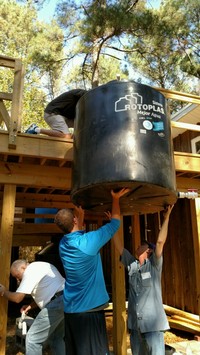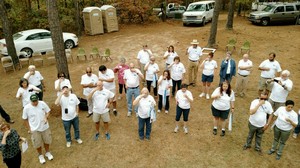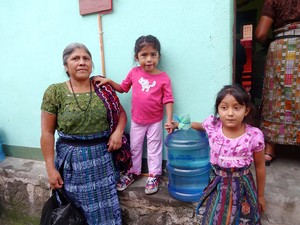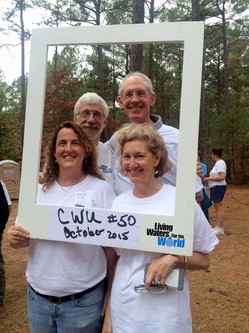The training component of the Living Waters for the World ministry—called Clean Water U—completed its 50th session this past weekend. The ministry has now trained over 2,000 volunteers to be part of water teams that build partnerships, install water purification systems and train communities in health and sustainability.
Living Waters for the World is a ministry of the Living Waters Synod of the Presbyterian Church (U.S.A.), located in the central southern region of the U.S. The ministry began in the early 1990s, when the Rev. Wil Howie saw the need for clean, potable water in Central American communities.
The majority of Clean Water U sessions are held at Camp Hopewell in Oxford, Miss., where a specially designed building is used to simulate the working conditions of a water purification system in the field. Additional trainings are held at Calvin Crest Conferences in Oakhurst, Calif., in an effort to bring the training to the western part of the U.S.
To date, 741 systems have been installed in 25 countries, including in the U.S., by a broad array of ecumenical and civic groups, although the vast majority of water teams come from PC(USA) contexts. The ministry has established 11 locally staffed support networks in foreign countries to support the ongoing needs of partnership development and maintenance for existing clean water systems. Aside from a few specialized parts produced in the U.S., most of the parts needed to keep the group’s custom-designed water purification system running can be found in each installation country.

Installing a water collection tank at Clean Water U. —Kendall Cox
Although providing clean water to needy communities is the end result for Living Waters for the World water teams, the ministry is primarily focused on partnership development, sustainability and long-term health for the people the systems serve.
“My observation is that the number one thing that the training experience brings to a water team is not how to put together a water system,” says Steve Young, Living Waters for the World executive director. “What we talk about is what exactly is involved to create a sustainable partnership to serve a generation. [Long-term relationship] is the bedrock for all the dynamics that are going to allow that operating partner to be independent and self-sufficient.”
And, as with many mission projects, participants who volunteer to serve say they are more enriched by the experience than they expected.
“I’m always amazed at the spiritual nature of the Clean Water U experience,” says Joanie Lukins, a Clean Water U instructor, curriculum writer and water team leader who has been part of 16 installations since she first became aware of Living Waters for the World in 2003.
“Every student who has come through the program has agreed that it was five days of a deeply spiritual experience,” Lukins continues. “To be in the company of 40 or 50 other people who are passionate about this mission, and who believe they’ve been called by Jesus Christ to this clean water ministry—that is an incredible experience.”

Clean Water U participants prepare to taste clean water treated by their class. —Kendall Cox
Water teams are the core unit of the ministry. Each team sends at least three representatives to Clean Water U, each to be trained in one of three course tracks: 101 - partnership building; 102 – health and sustainability; and 103 – water system installation and maintenance. Other team members are invited to participate as well, along with the sponsoring church, presbytery or other organization.
Communities in need of clean water are identified by the local network groups and via other partnerships. Young says a small minority of water teams have existing partnerships; the rest are recommended by Living Waters for the World. Living Waters for the World specifies a minimum three-year, four-trip strategy—what they call a covenant—with partners to ensure the success of clean water systems in a community.
A relationship-building trip takes place prior to transporting any water purification equipment to the intended location. The Rev. Todd Jenkins, a water team leader of seven installations and a Clean Water U instructor from Fayetteville, Tenn., says these trips are the most important part of the process.

Guatemalan family receiving their first bottle of safe water from a new Living Waters for the World system. —Todd Jenkins
“Going to your installation site, you’re thinking about the economics of it all,” says Jenkins. “When it’s finished, you’ll have $20,000 to $30,000 into the project, and you’re concerned that it’s going to work long-term. But once you get down there and start working with folks, you know you have to empower them to take ownership of and operate the system. And as you start developing relationship with them, you realize that, in essence, you have really gone down there to be saved. It changes your life as much or more than it changes theirs.”
The second trip delivers the technology to partners and installs the purification system. Training also accompanies this trip as the technology is transferred to the eventual operators, who help with the installation and learn about its continued use and maintenance.
“Our basic system is one that is pretty simple, and it’s one that can be sustained,” says the Rev. Carson Salyer, associate pastor at Westminster Presbyterian Church in Nashville, Tenn., and a Clean Water U instructor and water team leader who has worked with nine system installations in Peru and 14 in the Appalachian region of Tennessee. “There are some systems that have been refitted that are almost 20 years old.”
Two follow-up visits are required by Living Waters for the World to ensure the system is operating correctly and to work with partners to make any needed modifications in the production, location or delivery of clean water to the community. Some groups continue the relationship by bringing clean water systems to surrounding communities or engaging in other ministry opportunities.
“Living Waters for the World fosters involvement and it helps people develop a passion to have clean, pure water,” says Salyer. “A lot of people can’t go up to Appalachia or to Peru to help put in a system. But they support us with their prayers and they support us with their finances. . . . The involvement of the congregation is not only those on the water team who can make the trips, but it involves those who can support us financially and pray for us and encourage us—and really want to know how things are going.”
“I keep remembering [Living Waters for the World founder] Wil Howie saying, ‘This is a tangible way to care for our neighbors,’” says Lukins. “And of course, we know who our neighbor is—Jesus told us who our neighbors are. But North Americans have the need to be doing something all the time. It’s not enough for us to just travel with or be with our brothers and sisters in other areas. Living Waters for the World gives people a way to do something tangible, while at the same time developing relationships, which are the core value for us.”

